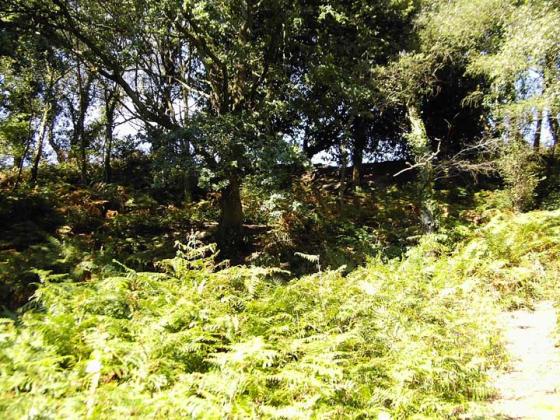Details of Badbury Barrow and stone on Pastscape
(ST 9602) The ‘Badbury Barrow’, which yielded remarkable finds when destroyed in 1845, was situated near Badbury Rings (ST 90 SE 45). Under the barrow mound, which was some 60 feet in diameter and 9 feet high, a central cairn of sandstone blocks was enclosed in a ring of flints bordered by a circular sandstone wall 30 feet in diameter, Within the cairn were at least three inhumations, apparently primary, two of them with food-vessels and one with an ornamental handled pot. Also probably in the cairn were at least fifteen cremations, a few perhaps primary, but most of them secondary, some with collared urns. At the centre, a huge slab of sandstone weighing half a ton was decorated with cup marks and carvings of daggers and axes similar to those at Stonehenge.
Opening another barrow in the same field, J.H. Austen found a primary cremation in a bucket urn with four lugs, in a charcoal
filled cist. (For possible sitings of these barrows see ST 90 SW 14 and ST 90 SE 52). (1-4)
A report on an opened tumulus one mile south of Badbury Rings bears many similarities with the feature recorded by authorities 1-4, and is probably the same barrow but seen by authority 5 at an earlier stage of its destruction. The barrow was 8 feet high, 225 feet in circumference and was opened for the purpose of obtaining flints. At 12 feet in from the outer edge, a circular wall of sandstone blocks, 3 feet high, was encountered, ‘laid in a rude manner’. Within this was a fill of flints (of which 120 cartloads were wheeled away) shelving down towards the centre of the barrow. The nucleus consisted of chalk and ‘mould’, below which were 5 cists. Two secondary internments were noted. (The account of the barrow was communicated to the author by Dr Wake-Smart who compares the barrow to the tomb of Aepytus observed by Homer in Arcadia. Warne (auth 3) in his account of the Badbury barrow notes that Wake-Smart makes exactly the same comment concerning the Badbury barrow. There can be little doubt that authorities 3 and 5 are therefore refering to the same barrow).
Only 3 of the 10 or 11 urns discovered in 1845 have survived, but these indicate a Middle Bronze Age date. The carvings on a kerb-stone represent bronze weapons and cup-marks.
The decorated surface of this stone was detached from its block and is now in the British Museum. (7)
Full description of the pottery and carved kerb-stone. (8)



























































































